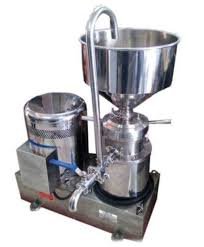Colloidal Mill: Construction, Working, and Principle of Operation

Colloidal Mill: Construction, Working, and Principle of Operation
1. Introduction
A colloidal mill is a type of mechanical equipment used extensively in the pharmaceutical, cosmetic, food, and chemical industries to reduce the particle size of solids in suspensions and emulsions. It is especially useful for producing colloidal suspensions (fine dispersions of particles in a continuous medium).
2. Construction of a Colloidal Mill
The main parts of a colloidal mill include:
-
Hopper:
Where the product to be processed is fed into the mill. -
Rotor and Stator:
The heart of the colloidal mill. The rotor rotates at high speed (typically 3000 to 15000 RPM), while the stator remains stationary. Both are made of hard, abrasion-resistant materials and have narrow gaps between them. -
Adjustment Mechanism:
Controls the gap between the rotor and stator, which determines the final particle size. -
Motor:
Powers the rotor. The motor speed and torque influence the shear rate. -
Discharge Port:
Processed material exits through this outlet. -
Cooling System (optional):
Circulates coolant to manage the heat generated due to high-speed operation.
3. Working of a Colloidal Mill
-
The material (suspension or emulsion) is introduced into the hopper.
-
Gravity or pressure feeds the material into the space between the rotor and stator.
-
The rotor spins at high speed, creating intense hydraulic shear, turbulence, and centrifugal forces.
-
These forces reduce the particle size and ensure uniform dispersion of particles in the liquid medium.
-
The processed material is collected at the discharge port.
4. Principle of Operation
The colloidal mill works on the principle of high shear force. It operates using the following mechanisms:
-
Shear Stress:
The high-speed rotation of the rotor against the stator creates a strong shear field that tears apart particles and droplets. -
Impact and Turbulence:
High turbulence and impact in the narrow rotor-stator gap enhance particle breakdown. -
Centrifugal Action:
The material is forced outwards through the narrow gap, aiding in size reduction and emulsification.
This combination of mechanical forces ensures that particles or droplets are finely dispersed, typically in the 1 to 10 micron range, and sometimes even smaller.
5. Applications
-
Pharmaceuticals: Preparation of ointments, creams, and suspensions.
-
Cosmetics: Emulsions, lotions, and gels.
-
Food industry: Mayonnaise, peanut butter, sauces.
-
Chemical industry: Paints, lubricants, dyes.
6. Advantages
-
Efficient size reduction and emulsification.
-
Easy to clean and operate.
-
Continuous operation possible.
-
Suitable for both liquid and semi-solid products.
7. Limitations
-
Not suitable for hard or abrasive solids.
-
Generates heat, which may affect heat-sensitive materials.
-
High energy consumption.
-
Limited to relatively low-viscosity materials.
🎓 Discover one of the best Pharmaceutical Production courses available — click below to explore the course that’s shaping future Production skills.

